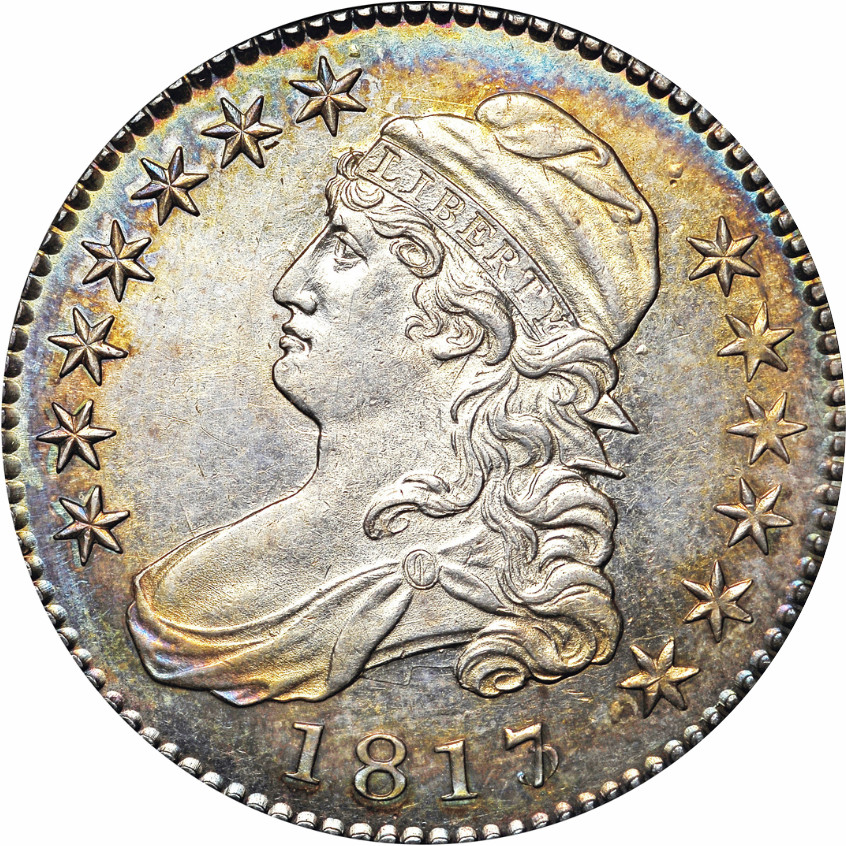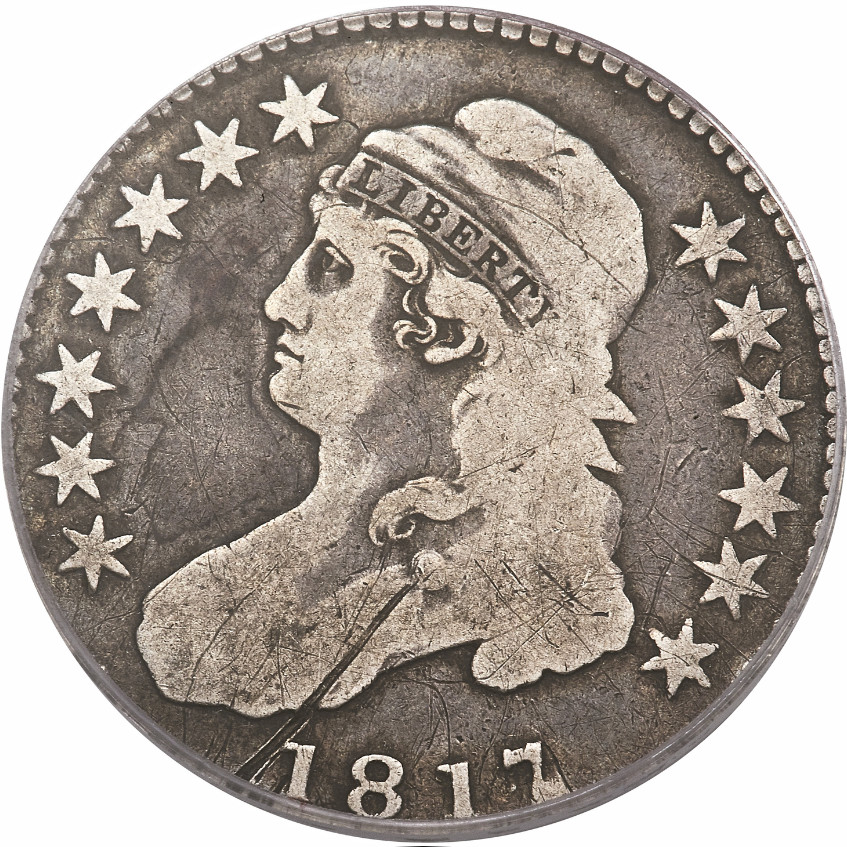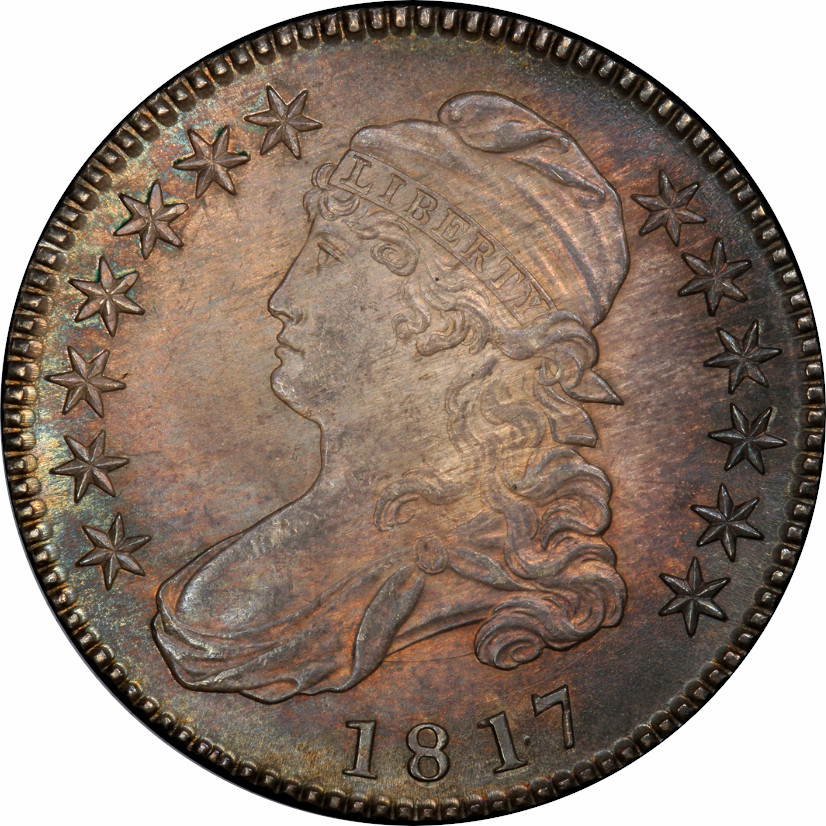
This week, it was my turn here at AoC to bite off more than I could chew. As an avid variety collector, I find scarce die varieties intriguing. I surely enjoy the idea of having something very few people have, so an R.5, R.6 or R.7 die variety always gets my attention.
But, as a dealer and before, from hearing from dealers, I know it’s true: there just aren’t that many people collecting by die variety. Compared to type collectors, the number of Sheldon or Overton Collectors is miniscule.
But, it’s still fascinating, and no matter what anybody says, there is a premium for a scarce die variety. But what is really scarce?
“Hand Made” U.S. Coins
Just like Early Copper, Capped Bust Halves were created using hand-made dies. As such, these coins have incredible character, and there are many unique die marriages (obverse and reverse dies struck together) creating a plethora of varieties.

What’s interesting about this particular example, which recently sold for close to $100,000, is that ICG graded it VG 8 Details for the massive obverse scratch. PCGS later net graded the coin Good 6. PCGS may know better than me on this one, but I disagree that the scratch is only worth 2 points. Not that it matters for an R.7 variety of a popular series…
Some collectors collect coins by year, some by year and mint mark. But The Few, oh those special few… Those who have tenacity, courage, and resilience and patience – they go for the whole shamozzle. There aren’t many capable of attacking the complete Sheldon or Overton Set. But collectors do.
My goal today is to help you answer the question: should I buy a scarce variety or spend the same money on a nicer coin.
It’s a tough question, and no matter how you cut it, it’s your money and you have to flip a coin. Unless your name is Uncle Moneybags, in which case the answer is simple you idiot: GET THEM ALL.
Unfortunately, we’re not all Uncle Moneybags. So, for the rest of us…
The 1817 Capped Bust Half Dollars for Today’s Study
For today’s article, I studied 1817 Capped Bust Half Dollars. I looked at 10 years of auction records for the following varieties: 1817 O-101 (R.3), O-102, (R.7), O-103 (R.2), O-106a (R.4), O-109 (R.2), O-110, and O-111 and O-111a (R.1).
I picked 1817 because it has a large breadth of die varieties with unique rarities. Some are Red Book varieties and some are not.
I suspected that rarity didn’t play an important role in die variety price as much as whether or not the variety was listed in the Red Book.
It’s limited data, so it’s a little noisy and tough to draw conclusions from, but what I found is seriously interesting.
First, the varieties:
1817 O-101, R.3: 1817/3 Capped Bust Half Dollar – Red Book variety
1817 O-102, R.7: 1817/4 Bust Half – Red Book variety
1817 O-103, R.2: 181.7 Punctuated Date CBH – Red Book variety
1817 O-106a, R.4: Single Leaf under Wing Capped Bust Half – Red Book variety
1817 O-109, R.2: minor variety 1817 Capped Bust Half Dollar – not specified in Red Book
1817 O-110, R.2: minor variety 1817 Capped Bust Half – not specified in Red Book
1817 O-111, 111a, R.1: common minor variety 1817 Capped Bust Half Dollar, not specified in Red Book
So you can see, I picked a good year with a lot of choices.

The Value of Condition
Here’s what I found:
Using the 111 and 111as together as a baseline, I found that there is an average of about a 225% increase in price per 10 grade points. That’s not solid, and it varies. As you well know, common coins stay common (less expensive) and scarce coins get scarcer (more expensive). There was only a 125% difference between Good (I used 6 as a baseline) coins and coins grading Very Good (10), whereas by the time you jump from 50 to 60, the jump is 350%.
Of course, once you get into uncirculated coins, the double can happen every point. When you get to finest-known grades, 5 and 10x increases between points or even half-points is commonplace.
When I looked at the R.2 varieties together, I found that on average the jump is about 285% per 10 points. It’s higher all the way through – which I found interesting. The higher the grade, the higher the jump, with the 50 – 60 jump took 450%.
Kinda makes sense. Substantially fewer coins overall, substantially fewer nice coins.
When I looked at R.3 and higher, a problem arose. Not too many Unc pieces have sold in the past 10 years. Also makes sense: the scarcer the coin, the fewer that trade. If I take out the 50-60 jump to keep the data honest, R.1 the average jump per 10 points fell to 200%, and the R.2 average jump came down to 230%. Interesting, right? R.3’s average jump between each 10 points was also about 235%. R.4 was actually down to 175%, but again, that’s because not only were there few Uncs selling, there were few AUs.
As you can see, I have three R.2 varieties listed. This is on purpose (two would have done, but since I wasn’t sure how the data would shake out, I tabulated 3.)
The Value of a Being a Variety Listed in the Red Book
Two of the R.2 varieties were very similar. One was not. Can you guess which one?
Of course, it was the Red Book variety, O-103. What may be skewing numbers more than normal here is that a couple of top of census coins, a PC5 and a PC64+, sold within the last ten years. There’s one PC5 coin, one PC4+ and one NG4+. Those two sales are going to skew things a bit because it’s the only variety with monster coins selling. The 5 sold for $36k in 2018 and the 4+ sold for about $26,000 in 2015, both through Heritage.

But still, you have to know that Red Book varieties are popular
The jump between 10 each points was, on average, 100% for the 109 and the 110. It was 180% for the 103.
So grades aside, what’s the value of one rarity point?
Depends if it’s in the Red Book or not.
Let’s look:
The average sale price for the 111s (R.1) at bottom of AU was about $1050. For the R.2 varieties, 109 and 110, it was $1110 and $1190. A difference, but a small one. For the O-103, it was $2,600.
The R.3 variety I chose, 1817 O-101 is also a Red Book variety: 1817/3. The average bottom AU sale price was $3680.
The R.4 is yet again a Red Book Variety – the 1817 Single-leaf CBH. The average sale price taken to bottom of AU was only $2170. So that’s interesting, right? R.4 is 76 – 200 on the numismatic rarity scale
So there plenty of Red Book variety collectors in the Capped Bust Half series, but perhaps fewer than required to eat up all 76 – 200 coins, of which only a portion of course are AU.
And here’s where things get really interesting.
How Many Big Money Collectors Are There in Capped Bust Half Dollars?
Only one O-105, an R.5 NON-Red Book variety sold at auction. And it sold for $18,800. R.5 is 31 to 75.
There’s only one 1817 O-105 PCGS AU55 (top graded) and one NGC AU 55. So R.5 as a variety, high R.7 by condition.
Going back to the 106a, there are a few single leafs in AU and the top-pop is a 62.
Not a common coin, but AUs I looked at are not the ONLY coin in that grade. Interesting, right?
So this study has taught me a lot. First, the Red Book drives collecting. We knew that, but it’s nice to see the data verify it, unquestionably.
And in this case, you have to get to an R.5 variety before competition is fierce among non-Red Book variety collectors.
So, to answer the age old question: for the same money, should I throw my money at a nicer coin or a scarcer coin, the answer seems to be unexpected. For now:
Get the Red Book variety. You’ll always be able to sell it.
More next week…
